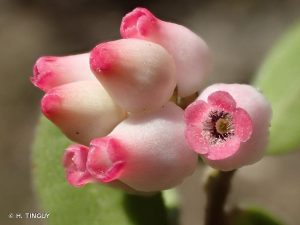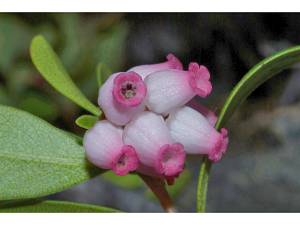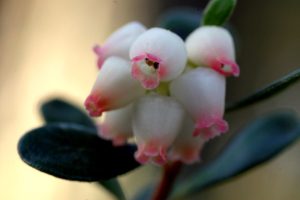A mat-forming evergreen shrub which produces lovely pink flowers that later turn into red berries and grows along coastal bluffs, in prairies, rocky areas, dry subalpine meadows, and dry coniferous forest openings.

At a glance
- Plant type: Shrub.
- Distribution: This plant grows from Alaska to California, east to the Rocky Mountains and across the northern U.S. and Canada to the Atlantic coast. This plant grows on both sides of the Cascades crest and at the coast in Washington.
- Height: This plant grows up to 8 inches (20 cm) in height.
- Flowers: Small pink bell- or urn-shaped flowers are produced in few-flowered drooping terminal clusters near the tips of the stems. The flowers are less than 1/4 of an inch (5 mm) in length.
- Leaves: Alternate leaves are produced, oval in shape, dark green and shiny on the upper surface and paler on the lower surface with a leathery texture. The leaves grow approximately 1/2 of an inch to 1-1/4 inch (1 to 3 cm) in length.
- Fruits: Kinnikinnick fruits are called drupes and ripen late, continuing to stay on plants into winter. Each drupe contains 1 to 5 large, very hard seeds. The drupe is bright red in color and approximately 1/4 of an inch to 1/2 of an inch (7 to 10 mm) in width.
- Notable features: The branches are long, flexible, rooting, and velvety brownish-red in color. Pure stands of Kinnikinnick can grow to be very dense.
- Synonym: Arbutus uva-ursi

Restoration and Conservation
Birds: The berries are consumed by ruffed grouse, band-tailed pigeons, evening grosbeaks, sparrows, and other ground-feeding birds. Insects: The flowers attract bees and brown elfin butterflies.
Mammals: The berries are browsed by bears, foxes, and coyotes. The twigs are browsed by deer.
Kinnikinnick aids in erosion control and works well along highway embankments. This plant is recommended for revegetation projects in well drained soils and growth is good on gentle to steep sites and is mildly fire resistant.
Ethnobotany
Food Uses: Bella Coola have mixed the berries with melted mountain goat fat and served to chiefs at feasts. Blackfoot and Chinook have eaten the berries fresh, dried, or mashed and fried in fat. Carrier mix the berries with salmon eggs for a nutritious meal, or use them in soups.
Medicinal Uses: Blackfoot have used an infusion of plant, mixed with grease & boiled hoof to treat skin rashes, peeling scalp, and as a mouthwash. Blackfoot, Chippewa and Cheyenne have also smoked the crushed leaves with tobacco or by itself. Carrier have placed leaves on a piece of wood, roasted them to a powder and placed on cuts for rapid healing, or on boils or pimples. Cherokee use parts of the plant to treat urinary diseases. Cheyenne use mixture of leaves and bark in a tea or as a poultice to treat persistent back pain.
Landscaping and Propagation
This plant is a good groundcover for dry places and river banks. The berries persist into the winter.
Propagation by root cuttings has been accomplished successfully.
This plant works well in Western Washington gardens. For more native plant suggestions for your garden check out Native Plants for Western Washington Gardens and Restoration Projects.

References
Page Editors/Authors:
- Mayme O’Toole
- Sarah Verlinde
- Gerald B. Stanley





